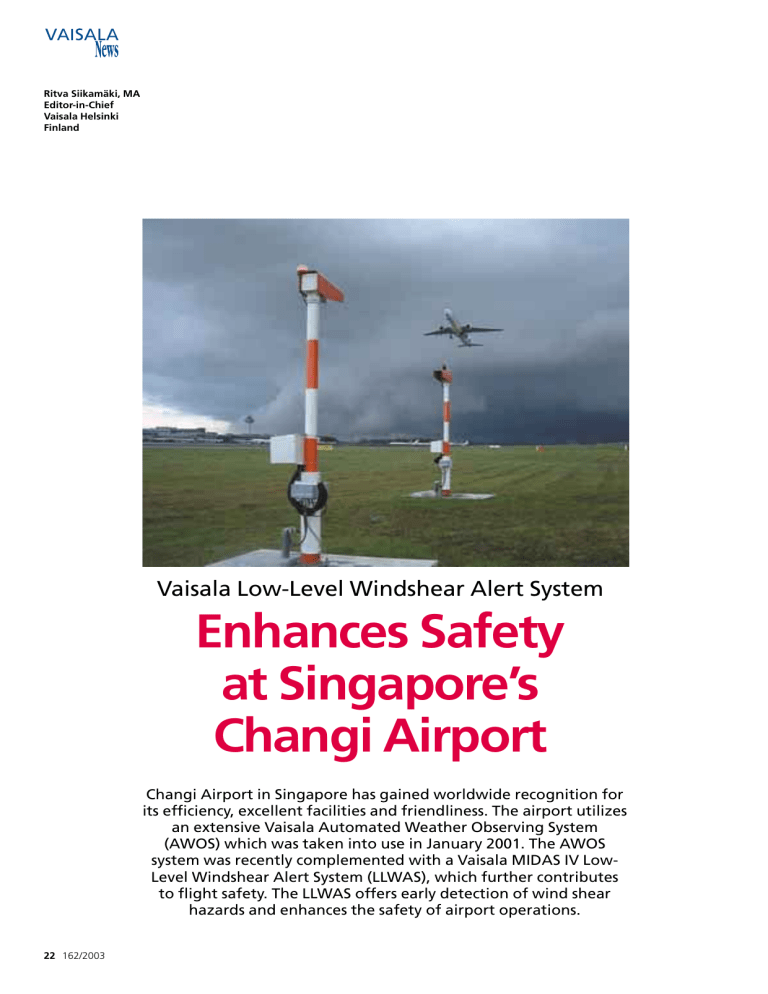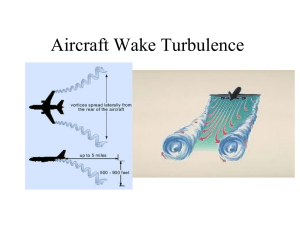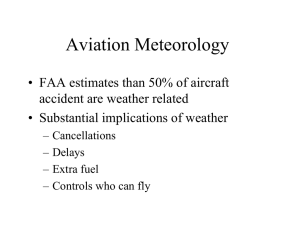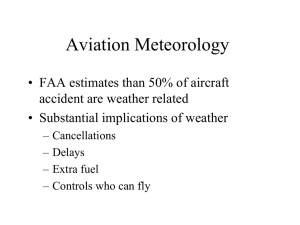
Ritva Siikamäki, MA Editor-in-Chief Vaisala Helsinki Finland Vaisala Low-Level Windshear Alert System Enhances Safety at Singapore’s Changi Airport Changi Airport in Singapore has gained worldwide recognition for its efficiency, excellent facilities and friendliness. The airport utilizes an extensive Vaisala Automated Weather Observing System (AWOS) which was taken into use in January 2001. The AWOS system was recently complemented with a Vaisala MIDAS IV LowLevel Windshear Alert System (LLWAS), which further contributes to flight safety. The LLWAS offers early detection of wind shear hazards and enhances the safety of airport operations. 22 162/2003 Some of the wind sensor sites at Changi are powered by solar panels. S ingapore is a sophisticated city state of three million people, a business, financial and tourist center in the heart of the new Asia. The city attracts thousands of visitors every year. They fly into Changi Airport which has grown and developed into one of the region’s leading airports, and a symbol of Singapore’s dynamism. A Vaisala MIDAS IV Automated Weather Observing System (AWOS) was delivered to Singapore’s Changi Airport during 1999–2000, one of the largest AWOS deliveries in Vaisala’s history. The MIDAS IV system collects, processes, monitors, distributes and archives meteorological data measured by a dedicated set of meteorological sensors located along the runways. The observations performed by the system provide Air Traffic Controllers and other personnel with the meteorological data required for Category II operations at the airport. Complementing the AWOS with a LLWAS The LLWAS System was installed in Changi Airport in late 2002 and early 2003. At the Civil Aviation Authority of Singapore (CAAS), Mr. Lo Weng Kee, Project Manager/Senior Engineer, acted as the project manager. The main contactor of this project was first Philips and then TYCO, with Mr. Victor Lee as the project manager. At SingTel Aeradio PL (SAPL), Mr. Won Phaey Yang, Technical Manager, Mr. Kway Song Moh, System Engineer, and Mr. Koh Yee Rui were involved in the project. Moreover, Infinite Communications PTE Ltd. acted as a subcontractor for Vaisala in the project, with Mr. Simon Tay and Mr. Xavier Chong as the responsible parties. The LLWAS System was purchased by the Civil Aviation Authority of Singapore and its installation was supervised by Working with the foundations of a wind sensor mast at Changi airport. CAAS’ consultant, SingTel Aeradio Pte Ltd (SAPL). Tyco (previously called Philips Singapore) was the main contractor for the supply and installation of the LLWAS, with Vaisala as its subcontractor assisted by Infinite Communications Pte Ltd. The Vaisala MIDAS IV LLWAS System is a ground based Wind Shear Alert System that incorporates the latest version of the phase III wind shear algorithm developed for the U.S. Federal Aviation Administration (FAA). The system provides wind shear and microburst warnings and alerts to air traffic controllers and other users at the airport. Additionally, the system provides detailed observation data of wind speed and direction information at the different sites. The LLWAS calculates alerts and warnings by processing wind data collected from an array of wind sensors at 14 sites in the airport. Fully integrated to the AWOS, the LLWAS utilizes the same computers and network as the AWOS. Moreover, the LLWAS is connected to the weather radar via TCP/IP connection which allows users to see warnings from both systems at the same time. The wind shear and microburst alerts from the LLWAS are shown on 20 work- ➤ 162/2003 23 The LLWAS sensor network consists of wind sensor sites on the runways and in their vicinity. Each site is equipped with wind speed and direction sensors, a transmitter, a VHF radio and an antenna. Existing masts were used where possible for wind sites. stations at various locations in the airport. The data is displayed on the operator workstation, forecaster workstation and weather data monitor. The reporting interval for wind data is 10 seconds. The LLWAS software interprets the data and detects when windshear conditions exist and issues alarms if needed. The Low-Level Windshear System at Changi has two Vaisala MILOS500 Data Collection Systems in the ATC Tower, also used as part of the AWOS system, which poll the sensors to collect wind data and then forward the data via a modem connection to both main computers (Central Data Unit, CDUs). Data is collected from the sensors via radio modem link. One of the MILOS500 stations acts as the primary station which con- 24 162/2003 stantly polls the wind sites. Both MILOS500 stations listen to the responses and then each sends the data seperately to both CDUs. In case the primary station fails to poll, the secondary one will take over the polling. The LLWAS processes and archives data polled from wind sensors and displays the verified raw wind data, as well as windshear and microburst alerts, in a variety of formats. The LLWAS provides data on windshear display which can be accessed on the meteorological workstations of the AWOS system. Duplicated system for safety All the critical parts of the LLWAS system are duplicated for maximum safety. The backup wind system is intended to collect vital wind data from runway end touchdown zones in case of AWOS system malfunctions. Measurement sites at the ends of the runways are equipped with duplicated wind sensors. Primary sensors are connected to the MIDAS IV AWOS via the MILOS500 field station and modem line. Secondary sensors are connected to the AWOS via radio link and a display in the ATC tower. In case the AWOS fails, the wind data is still seen displayed in the ATC tower. In case one of the touch down zone primary wind sensors fail, the system automatically starts to use the secondary wind sensor data. Duplicated LLWAS network Two MILOS500 stations in the ATC tower poll the sensor sites for wind data and then forward the data via modem connection to both main computers (CDUs). For data transmission from the wind sites, a radio link is used. The primary base station at the ATC tower sends one poll command every 10 seconds. Wind site 1 responds after a predefined time and sends back present wind speed and direction average values as well as measured battery voltages to the primary station. After that the sites respond in 0.5-second cycles. The messages are received at both primary and secondary base stations, which then send the data to CDUs via modem lines. In case the primary base station is not able to poll, the secondary base station will take over polling. Wind speed and wind direction are measured at each wind sensor site of the LLWAS network. The backup wind system consists of 4 wind sensor sites and a base station which collects the data. The base station is a Vaisala Wind Display WD50, located in the ATC tower. The data is collected via radio link. The WD50 polls each site at one-second intervals, with a whole cycle taking 4 seconds. In the LLWAS System, two different types of power supply are used. Some stations have only solar panels and others have a 230VAC power supply. The sites without AC power access are equipped with 2 solar panel modules (each 50W under standard conditions). The solar panels are connected via a charger to the batteries. The two solar panels, chargers and batteries form two independent power systems. The sites with AC pow- The base station receiver antennas are installed on the roof of the ATC tower. er supply are equipped with a 230VAC/12VDC converter and a battery charger unit for the backup battery, which are duplicated for safety and uninterrupted operation. Smooth cooperation According to Mr. Timo Rytövuori of Vaisala, who acted as the project manager for the LLWAS System delivery, cooper- ation with all partners was seamless, as it was during the earlier AWOS project. “With a successful project like this there is every reason to be happy with the results,” he points out. ● Among many others, Koh Yee Rui and Kway Song Moh of SAPL, as well as Hannu Heikkinen and Timo Rytövuori of Vaisala, worked with the LLWAS project. 162/2003 25



